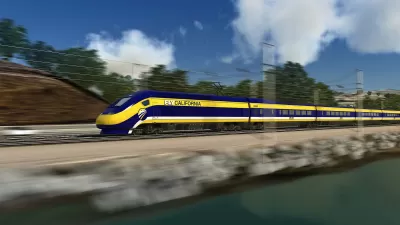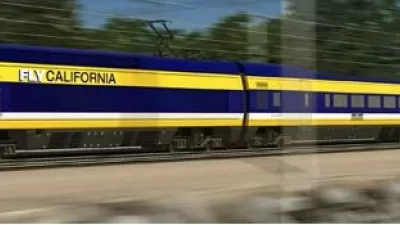Opposition, followed by legal action to the California High-Speed Rail project began in Northern California, spread to the Central Valley, and now has hit southern California, particularly in the San Fernando Valley of Los Angeles County.
In a series of articles, Ralph Vartabedian and Soumya Karlamangla of the Los Angeles Times examine the growing opposition to the project, including 300 people attending a June 9 High-Speed Rail Authority meeting in downtown Los Angeles. "Rail board chairman Dan Richard said the meeting was the biggest protest he could recall during his tenure."
As the detailed planning process begins to shift to Southern California, community leaders and neighborhood groups are launching challenges to a segment that would run between Palmdale and Burbank.
The meeting "followed the release of a key report that analyzed the effects of four different routes," they write. "The 62-page analysis shows that within half a mile of the track from Palmdale to Burbank, there could be noise and vibration affecting about 20,000 residences, 25 parks, 47 schools, 48 churches and nine hotels, as well as archaeological sites and wetlands."
Unlike opposition from three affluent, predominantly white communities on the San Francisco Peninsula, "several low-income and predominantly minority communities, including San Fernando, Pacoima and Sylmar, complained that their neighborhoods would be divided by 20-foot-high sound walls along the high-speed train corridor. Some said their areas had been already been chopped up by three major freeways and a dozen dumps."
In a related article, Vartabedian and Karlamangla write that "a coalition of communities is demanding that only routes that are predominantly underground should be considered."
The growing resistance is coming in part from urban, working-class neighborhoods that are portraying the surface route as an environmental injustice. Notably, those communities are longtime supporters of state Democrats who championed the project."
Vartabedian and Karlamangla detail the four routes. "It wasn't immediately clear how the outpouring of opposition might affect decisions about a route, which could take two years of environmental research and planning to complete."
FULL STORY: Bullet train runs into rising opposition over Southern California routes

Planetizen Federal Action Tracker
A weekly monitor of how Trump’s orders and actions are impacting planners and planning in America.

Maui's Vacation Rental Debate Turns Ugly
Verbal attacks, misinformation campaigns and fistfights plague a high-stakes debate to convert thousands of vacation rentals into long-term housing.

San Francisco Suspends Traffic Calming Amidst Record Deaths
Citing “a challenging fiscal landscape,” the city will cease the program on the heels of 42 traffic deaths, including 24 pedestrians.

Defunct Pittsburgh Power Plant to Become Residential Tower
A decommissioned steam heat plant will be redeveloped into almost 100 affordable housing units.

Trump Prompts Restructuring of Transportation Research Board in “Unprecedented Overreach”
The TRB has eliminated more than half of its committees including those focused on climate, equity, and cities.

Amtrak Rolls Out New Orleans to Alabama “Mardi Gras” Train
The new service will operate morning and evening departures between Mobile and New Orleans.
Urban Design for Planners 1: Software Tools
This six-course series explores essential urban design concepts using open source software and equips planners with the tools they need to participate fully in the urban design process.
Planning for Universal Design
Learn the tools for implementing Universal Design in planning regulations.
Heyer Gruel & Associates PA
JM Goldson LLC
Custer County Colorado
City of Camden Redevelopment Agency
City of Astoria
Transportation Research & Education Center (TREC) at Portland State University
Jefferson Parish Government
Camden Redevelopment Agency
City of Claremont




























